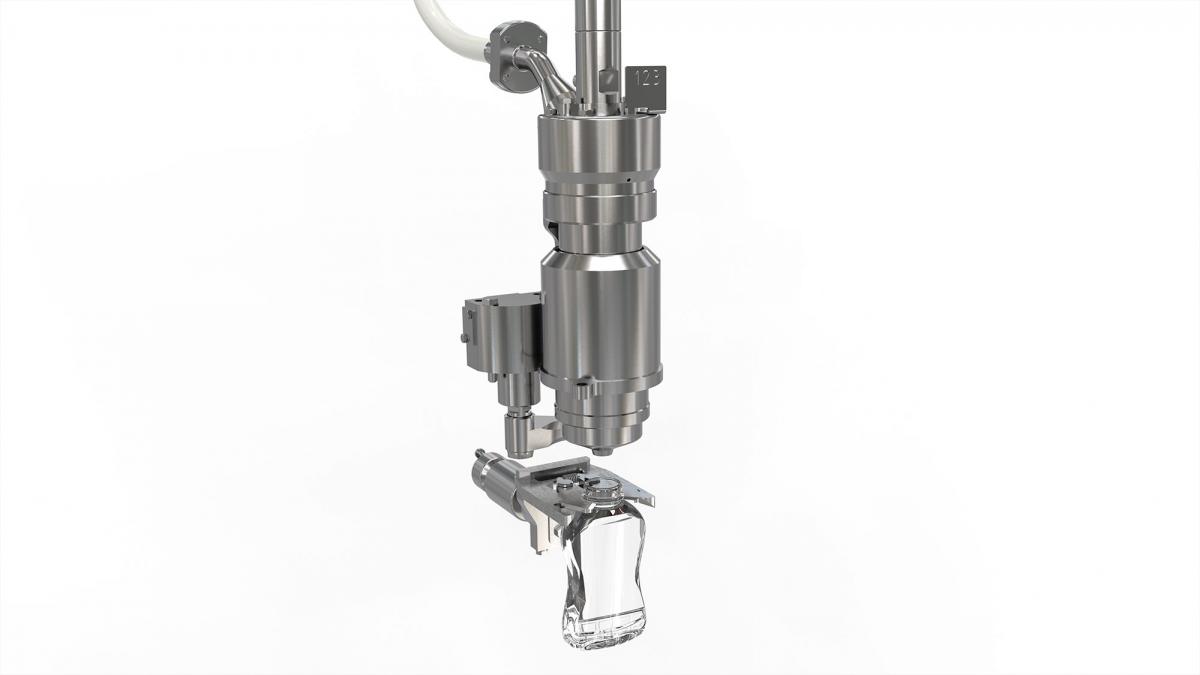Oils and dressings, plus condiment and table sauces, can be bottled much more precisely using a new generation of filling valves from Krones. Even in the high output range of up to 48,000 containers per hour. For this purpose, Krones has specifically equipped the Modulfill NWJ filler to handle highly viscous products. What’s special about it: the filler uses weighing cells to determine the precise fill quantity, irrespective of the product’s characteristics. Moreover, it features a filling valve developed specifically for sauces, flexible enough to cope with a huge array of disparate products.
For more than ten years now, Krones has been continually design-enhancing its sauce filling capabilities, so as to replace the traditional piston- or level-controlled filling by an even better and more accurate alternative. This has meanwhile been accomplished: though Krones had in the past already implemented some successful processes with weight filling in free-jet mode featuring a lowerable filling valve, the new Modulfill NWJ can nonetheless be justly described as a breakthrough – not least because of its new valve system and the Viscosity-Based Fine Pressure Control.

A new generation of filling valves enable more precise bottling of oils and dressings, plus condiment and table sauces. (Source: Krones)

The new filling system has been developed specifically for eliminating traditional filling problems, like elongated-drip formation at the discharge and thread formation or post-dripping.
There are several reasons why viscous products can now also be cold-filled cleanly, safely and hygienically:
1. The product is stored in the co-rotating central bowl, in which the pressure is continuously monitored. Using the newly developed Viscosity-Based Fine Pressure Control, nitrogen or sterile air is injected, depending on the product concerned, in order to maintain at a constant level the predefined pressure conditions in both the product tank and in the filling valve. Thanks to this continuous control, optimum filling accuracies are achieved – even with fluctuating product characteristics featuring different viscosities.
2. A product’s viscosity does not usually remain constant while a product batch is being filled, which in the case of conventional filling processes leads to under- or overfills. Not with Krones’ so-far-unique process: in addition to measurements using a weighing cell, the Krones filler accordingly takes time measurements as well. If predefined limits are violated upwards or downwards, the Viscosity-Based Fine Pressure Control will re-adjust the filling pressure and thus the flow velocity as well.
3. For optimum, clean and hygienic filling of products containing chunky particles, the initial product insertion is kept as small as possible, and maximally close to the filling valve. This simultaneously reduces product losses, too.
4. The electronic weighing cells enable the fill quantity to be determined with great precision. The system thus achieves optimum filling accuracies – with every product, irrespective of its conductivity or degree of viscosity.
5. The filling valve itself comprises a valve housing and an internal valve stem. When the bottle is being filled, the valve unit descends to just above the container’s mouth. At the same time, the internal valve stem, which is responsible for opening and closing the valve, can be separately actuated, thus varying the closing speed. Depending on the product involved, then, the valve stem’s filling and closing speeds are optimally matched to the characteristics of the product concerned, assuring maximised flexibility.
6. Viscous products tend towards thread-formation or post-dripping. This results in soiled containers, unnecessary product losses, and entrainment of product residues along the entire line. The solution has arrived in the shape of the Modulfill NWJ-Neck – featuring a valve geometry designed specifically for clean filling: a concave chamfer prevents elongated-drip formation and at the same time ensures a sharp cutting edge.
|
Avoiding traditional filling problems The new filling system has been developed specifically for eliminating traditional filling problems. • Simple, flexible adjustment of the flow velocity and the increased shear force acting on the product avoid both what is called folding, e.g. in the case of mayonnaises, and unwanted air inclusions. • Bubble entrainment with low-viscosity sauces, like ketchup, is correspondingly optimised, too, by a reduced flow velocity. • The variable discharge geometry of the valve stem reduces both elongated-drip formation at the discharge and thread formation or post-dripping, and ensures clean filling without soiled neck finishes. • Temperature- or batch-entailed inaccuracies in the filling process due to what are sometimes substantial fluctuations in the product’s viscosity are very largely smoothed out by the intelligent Viscosity-Based Fine Filling Pressure Control feature. |
Hygienic design
The Modulfill NWJ meets the most stringent of hygiene requirements: by means of fully automated CIP and SIP processes, plus an optional version featuring an automatic foam cleaning system or bottle and closure handling. For the closed-cycle CIP cleaning routine, the cups slot into place automatically; the CIP and sterilisation media are returned downwards. The tanks are sprayed out automatically as well.
As a stand-alone machine or a block solution the Modulfill NWJ is suitable for:
• hot and cold-filling of table and condiment sauces
• low-viscosity products from approximately 100 millipascal-seconds (olive oil, salad dressings)
• highly viscous products with a rheological yield point (mayonnaise or mustard) up to approximately 15,000 millipascal-seconds
• Products with separable particles up to a size of 6 x 6 x 10 millimetres – depending on the dimensions and particle consistency involved – with a content of up to 20 per cent (BBQ sauces with large chunks) or 75 per cent (whole-grain mustard, harissa, etc.) glass and plastic containers in base-handling and PET containers in neck-handling mode
In terms of layouting, too, the filler can be customised to suit the needs of the client concerned and the space available: the Modulfill can be supplied as a stand-alone machine, in conjunction with a closer and as a block solution with a rinser or a blow-moulder.
There are options for combining the blow-moulder/filler block with a ProShape module for producing oval and other special-shaped bottles, or with a Contipure preform sterilisation module using H2O2 to produce containers for sensitive products.
Air Max Flair KPU














